Augmented Environment: Learning Through Augmented Reality for Children with Pervasive Developmental Disorders
Adel Fridhi1* and Naila Bali2
1Research Laboratory on Disability and Social Unsuitability, Tunisia
2Higher Institute of Special Education, Tunisia
Submission:December 01, 2023; Published:January 10, 2024
*Corresponding author:Adel Fridhi, Research Laboratory on Disability and Social Unsuitability, LR13AS01, ISES, UMA, Tunisia, Email: adel.fridhi2013@gmail.com
How to cite this article: Adel F, Naila B. Augmented Environment: Learning Through Augmented Reality for Children with Pervasive Developmental Disorders. Glob Glob J Intellect Dev Disabil. 2024; 13(2): 555856. DOI:10.19080/GJIDD.2024.13.555856
Abstract
Our article focuses on the question of the potential of augmented reality (AR) in the educational action of people with pervasive developmental disorders (PDD). This study is part of specialized education (ES) where the teacher is encouraged to seek new support to improve the skills and abilities of our target population. The teacher is perceived as: “a person who promotes the implementation of specific methods and techniques... within a class or in a daily living environment”. Our research is interested in the question of the advantages of augmented reality in the care of children and young adults with PDD. The intention of our article is to highlight the advantages of the use of AR in the care of people with PDD. pervasive developmental disorder. Indeed, the design and 3D modeling of avatars and a daily virtual environment (EVQ) close to reality have established themselves in the field of specialized education, which presents numerous advantages.
Keywords: Augmented reality; Pervasive developmental disorders; Specialized education; 3D modeling; Avatars; Daily virtual environment
Abbreviations: WPDD: Pervasive Developmental Disorders; AR: Augmented Reality; SE: Specialized Education; EVQ: Daily Virtual Environment
Introduction
The term “pervasive developmental disorders” (PDD) is a group of mental disorders that are attracting intense and growing attention from psychologists, physicians, and neurophysiologists. These disorders manifest themselves in children through significant delays in the development of a certain number of fundamental functions, including communication and socialization. Thanks to the development of new technologies, 3D modeling of virtual environments prior to reality and the application of augmented reality on avatars has become possible. The term corresponds to an interactive experience of the real-world environment where certain things residing in the real world (objects, people, events, etc.) are supplemented (enhanced) by computer-generated perceptual information. Augmented reality can be defined as a system corresponding to three basic characteristics: it combines the properties of the real and virtual worlds, it allows real-time interaction, and it allows providing accurate 3D registration of real and virtual objects [1]. The evaluation of a subject’s attentional, emotional and executive functions through the creation of AR has particularly aroused the interest of researchers. The relevant area of research is still in its early stages, but the potential contribution of AR to the assessment of children with PDD appears promising, and these children will likely benefit from this technological innovation [2]. AR for the assessment of children with pervasive developmental disorder (PDD) appears very promising, and our target population will benefit from this new technology. The condition of children with pervasive developmental disorders (PDD) is generally assessed by expert teachers via “paper and pencil” methods, which are currently traditional. traditional methods have also been reproduced in digital mode thanks to new technologies, and subsequently the question is whether augmented reality would be a modality to assess our PDD population? “. The aim of our research is to provide an answer to our problem by providing complete information on the use of augmented reality. First, the cognitive functioning of children with PDD will be discussed according to various hypotheses. Next, AR and associated modeling will be described, as well as the advantages of this new technology. The creation of avatars will be considered, on the one hand, as a means of intervention with PDDs and, on the other hand, as a means of evaluating emotions. Finally, the discussion will focus on whether AR would be a more appropriate way to assess and improve the behavior of children with PDD [3].
Problem and Research Questions
Our research addresses the question of the advantages of the application of AR in the care of children suffering from a pervasive developmental disorder (PDD). Several studies and research have demonstrated the use of digital media and their beneficial role in the care of a population with specific needs, which requires immersive and interactive technical means. AR could be an educational support in the hands of specialized educators to meet the needs of people with PDD to improve qualitative alterations in communication and social interaction [4]. To this end, specialist educators for PDD children advocate the interest of using new technologies in improving the skills of this population and thanks to models and avatars, created by AR [5]. Autism is a current subject in this sense, specialized educators are called to take advantage of the interest of people with PDD to work with people from various fields by inspiring multiple and diverse methods and activities. These instruments play the role of facilitators and mediators, which is why they are used by professionals in special education as well as by families and parents of people with PDD. As part of this research project, the following research question will be asked: What is the impact of using AR in improving learning in children with PDD? [6]. For To do so, we pose the following research questions that we may or may not wish to address during our study. -What is the place given by specialized educators to the use of AR in the care of people with PDD?
Methodology
Object modeling and interactive training
Interactive and immersive training for children with pervasive developmental disorders helps to master more knowledge in each lesson, which is why augmented reality applications aimed at this population can be one of the ways to learn anatomy. Augmented reality essentially consists of interacting with avatars modeled in 3D, learning by this method is very easy because this model (Figure 1) is interactive with sound recording in such a way that the child can be in total immersion in the scene modeled in 3D while hearing (the words: two, three, four, etc....) (Figures 1a, 1b & 1c). In many teaching cases, theoretical knowledge is not enough to acquire adequate skills for PDD children and in specialization in general. in our case PDD learners should not be simple listeners and passive observers, this is why we need practice and concrete experience. Thanks to interactivity, augmented reality functionalities can transform a virtual environment into a nearreal environment. With AR and 3D modeling, PDD can gain some experience later. It is no surprise that this population will be engaged, understand the subject better and learn faster (Figure 2) [7].
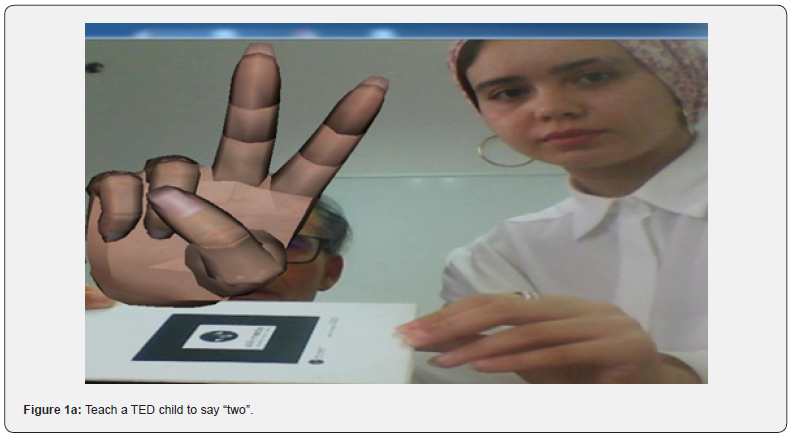
Learning in augmented reality at all ages
Despite everything, AR has the potential to profoundly disrupt the education system. and this, because it is applicable to all ages.
i. In primary and secondary. AR apps can be used in the classroom to improve understanding of the subject. They allow you to explore more complex topics (like math, physics, etc.) in an interactive and engaging way. It is also a good way to stimulate the creativity of young people.
ii. In higher education. AR solutions are becoming more and more popular in universities. They are, for example, used in the humanities and technical sciences to stimulate student engagement and make the learning process more effective. In chemistry, for example, AR facilitates learning anatomy (Figure 3).
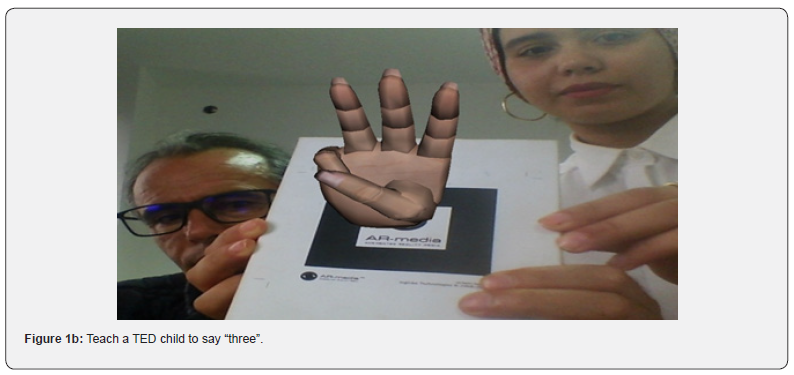
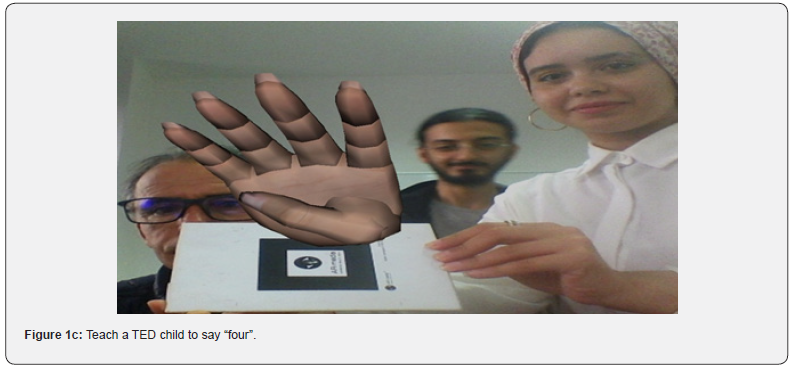
In professional training. Thanks to AR learning, it is easier for profiles of DPs undergoing retraining to acquire new skills. Learning in augmented reality will allow them, for example, to handle new equipment in complete safety (Figure 4). But also, to understand their working environment in practice. Research has shown that augmented reality-assisted training improved comprehension for PDD children by 40%. This increase is thanks to real-time interaction and immersion.
Results and Discussion
Sports education has been considered a therapy session for children suffering from a pervasive developmental disorder. The use of immersive and interactive real-time AR in this area could be a very innovative approach for the target people, it can make this population usually distant. Evaluation of these devices is necessary to adapt this technology. Therefore, AR is an innovative technique we used to measure the acceptance of several children with PDD [8]. Our study relies on the automatic effectiveness of digital skills and attitudes to show good acceptance of AR for this population [9]. We have this technology to evaluate the acceptance of AR to promote physical activity [10]. Our research is built from several models, analyzing AR and its influence on the individual behavior of this population [11]. Physical inactivity linked to PDD is a major public health problem of the 21st century. Among the new technologies likely to improve the physical and mental preparation of PDD people: AR, which has benefited from significant advances over the last decade. Its dazzling progress, particularly in the development of 3D and 360-degree virtual environments, offers athletes the opportunity to train differently, in addition to their traditional practice. Augmented reality makes it possible to “cheat” with the environment, to isolate the sub-skills that the learner will need to excel in to train them individually. A real asset for PDD children, who can thus repeat certain movements in isolation, in an environment close to real life, while minimizing the risk of injury. The equipment made available for the project allows the following activities: (Figure 5). In a free space, for PDD participants, the sporting gestures, our example is played in a closed space. The virtual environment presents an avatar in a physical activity position.
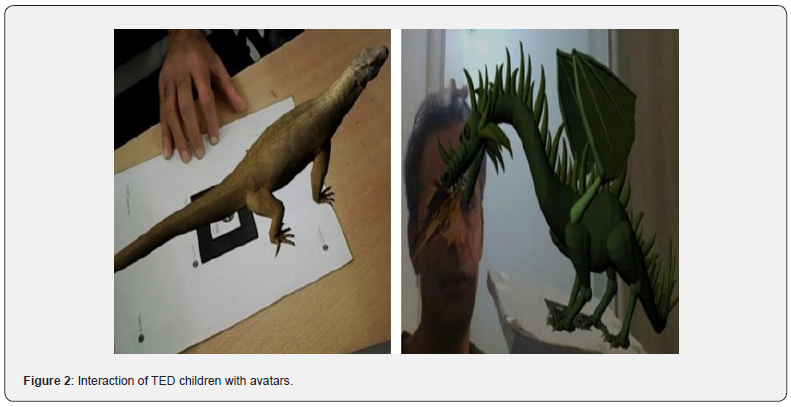

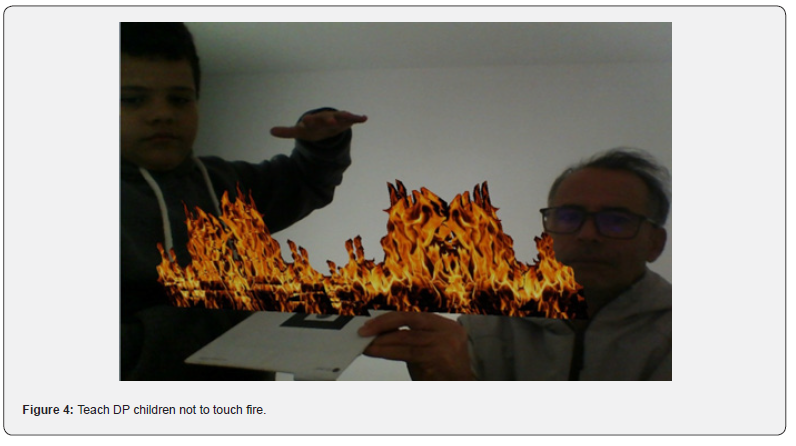

Conclusion
The integration of augmented reality in large stores is becoming an increasingly common practice, more precisely in the field of education. With this new method of learning aimed at PDD children, the present research aimed to analyze from a practical point of view how the application of AR affected several huge skill variables in this population. The results of our research work in the analyzes after carrying out the practical part showed how the experience with AR improved all the evaluated variables [13]. Moreover, contacting this technology has enabled children with PDD to improve their perception of learning and to arouse their interest and knowledge. Finally, and based on the questions asked at the beginning of this research, the results obtained provided motivating answers to go very far with this new learning method.
References
- Fridhi A, Bali N, Rebai N, Kouki R (2020) Geospatial Virtual/Augmented Environment: Applications for Children with Pervasive Developmental Disorders. Neurophysiology 52(3): 239-246.
- Laribi R, Fridhi A, Rebai N (2021) The impact of augmented reality in improving non-verbal communication in children and young adults with autism spectrum disorder (ASD). Int J Edu Learn System 6.
- Fridhi A, Benzarti F, Frihida A, Amiri H (2018) Application of virtual reality and augmented reality in psychiatry and neuropsychology, in particular in the case of autistic spectrum disorder (ASD). Neurophysiology 50(3): 222-228.
- Fridhi A, Bali N (2021) Science Education and Augmented Reality: Interaction of students with Avatars Modeled in Augmented Reality. Int J Environ Sci 6.
- Fridhi A, Bali N (2023) Augmented Reality in Sports Education and Training for Children with an Autism Spectrum Disorder. Neurophysiology 54: 74-79.
- Bouajila A, Jebahi A, Fridhi A (2023) Use of Augmented Reality in Education. Int J Innovative Sci Res Tech 8(9).
- Bali N, Fridhi A, Hassen Z (2022) Coronavirus: introduction of the application of augmented reality to help children with disorders to overcome the phobia of contamination facing an indefi nite end of the pandemic. Romanian J Neurology 21(2).
- Pedroli E, Greci L, Colombo D, Serino S, Cipresso P, et al. (2018) Characteristics, Usability, and Users Experience of a System Combining Cognitive and Physical Therapy in a Virtual Environment: Positive Bike. Sensors (Basel) 18(7): 2343.
- Huygelier H, Schraepen B, Van Ee R, Vanden Abeele V, Gillebert CR (2019) Acceptance of immersive head-mounted virtual reality in older adults. Sci Rep 9(1): 4519.
- Syed-Abdul S, Malwade S, Nursetyo AA, Sood M, Bhatia M, et al. (2019) Virtual reality among the elderly: a usefulness and acceptance study from Taiwan. BMC Geriatr 19(1): 223.
- Fuad A, Hsu CY (2018) UTAUT for HSS: Initial framework to study health IT adoption in developing countries. F1000Res 7: 101.
- Bull FC, Al-Ansari SS, Biddle S, Borodulin K, Buman MP, et al. (2020) World Health Organization 2020 guidelines on physical activity and sedentary behaviour. Br J Sports Med 54(24): 1451-1462.
- Gómez-García G, Rodríguez-Jiménez C, Marín-Marín JA (2020) La trascendencia de la Realidad Aumentada en la motivación estudiantil. Una revisión sistemática y metaaná Alteridad 15(1): 36-46.






























